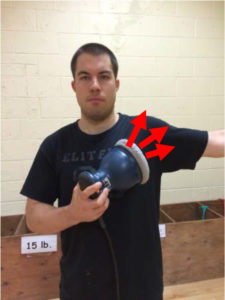Whenever you perform a workout, you’re exposing your body to a challenge- a form of stress. In order to describe and quantify the character and extent of that stress, we use the phrase “loading parameters.”
Generally these parameters refer to the load used, the number of sets and reps performed with that load, as well as the rests between sets and the speed of movement used on each repetition. However, other parameters can be monitored as well, including frequency of workouts, the number of exercises per workout, the order of exercises within a workout, the duration of each workout, and so on and so forth.
With that in mind, I’ll share a few thought about loading parameters…
“Work” is defined as displacing a load for a specified distance
This is an important distinction, because most people wrongly confuse work with the effort it took and/or how it felt to perform that work. In fact, it’s possible to have a high perception of effort during low-output performances. An example of this is using purposely slower-than-necessary repetitions- they hurt more, but accomplish less. Perhaps an even better example is static contractions, which hurt a lot, even through (technically-speaking) you’re not performing any work at all.
Bottom line: “work” is what you did, what you produced, not the resources you consumed to do it.
“Power” is defined as how quickly a load can be displaced for a specified distance
Accomplishing work in a shorter period of time means you’re more powerful than someone else who took longer to perform the same task. This is what almost every competitive sport is all about.
A single parameter can only be appreciated against the context of the other parameters
If you perform 2 sets of 8 reps, is that the same as performing 4 sets of 8 reps? Clearly it isn’t. Therefore, advising someone to perform “8 reps per set” has no real meaning unless you also specify how many sets should be performed.
Similarly, performing 8 reps in 15 seconds is not the same thing as performing 8 reps in 25 seconds. Performing 8 reps with a 9RM load is clearly different than performing 8 reps with a 12RM load.
The point is this: no single parameter has significant meaning unless it is understood against the backdrop of all other parameters. Remember this the next time you hear say “high reps are for tone” or “low reps are for bulk.”
Loads should be earned, not assigned.
To say that you “should” perform 6 sets of 2 with 242 pounds during next Wednesday’s bench press workout is absurd. It’s fine to use those numbers as a goal, but you have no way to predict your functional capacity on a future date. If you’ve over-estimated your capacity, you risk over-extending your adaptive resources and/or injuring yourself as you stubbornly try to complete your assignment. Conversely, if you under-estimated your capacity, you might lose the chance to hit a new PR, or at the very least, you’ll under-train your bench presses for that workout.
On any given workout, a superior performance (at least in the case of trained individuals) indicates a high functional capacity, and it’s an indicator that the previous training cycle has produced good results. It’s time to “strike while the iron is hot” as the saying goes.
Inferior performance, on the other hand, indicates inadequate recuperation from previous workout loads and suggests the need for rest, not work.
Balancing Specificity Against Variation
First, your training must reflect both requirements- it must be specific enough to render a result, but not so specific that you stagnate and/or develop overuse injuries. The best way to walk that fine line is through the use of what I would term “worthwhile” exercise families, as follows:
Squats
Olympic lifts
Horizontal Presses
Vertical Presses
Vertical Pulls
Unilateral lower Body Drills
The exercises in each category are all cousins of each other: Back squats, front squats, Zercher squats, overhead squats, box squats, and thrusters are all squats, but they’re all different types of squats. Squatting is “worthwhile” because there are so many variations of this exercise, you can do them all the time without stagnating. Same with the other categories listed above.
Quality And Quantity Are Inversely Related
You can’t run a marathon at 100-meter speed, and you can’t perform 10 reps with your 1RM. Volume and intensity must always be balanced. First establish quality (speed, strength, movement quality, asymptomatic joints) and then, if desired, increase quantity.
Strength Is Fundamentally “Motor Intelligence”
Many people under-estimate the neural component of strength training. Although it is true that a thicker muscle fiber can produce more tension than a thinner fiber, the fact remains that muscles are slaves of the nervous system. Most people have enough muscle tissue to accomplish impressive physical tasks. What most people lack is efficient wiring. Only heavy loads, lifted in a relatively fresh state, help to motor cortex improve its force production strategies: inter and intra- muscular coordination, rate coding, and so on. If you value pain over performance, you’ll probably rarely train in the necessary manner.
Resources Are Finite
If your adaptive resources were unlimited, you’d be well-advised to train as hard as possible, as often as possible. But unfortunately, you’re ability to recover from workouts requires a number of resources, all of which have limits. This being the case, you should always strive for maximum efficiency in each workout. By efficiency I’m referring to the resource/production ratio of your efforts. For every unit of resource, you’re looking for produce as many units of work as possible. Smart manipulation of loading parameters is the key.
Always Assume You’re Under-Appreciating Specificity
If your training isn’t producing the results you want, I’d look at specificity first. When in doubt, be more specific, not less. Even seemingly non-specific tactics are often highly specific when examined carefully. Example: A powerlifter practices pin presses instead of bench presses to improve his bench. This seems less specific than simply benching, but if the pin presses are performed under the premise of weak triceps, it becomes clear that pin presses are more specific to the issue of triceps strength than are bench presses.
The Strength/Technique Relationship
Strength and technique are often assumed to be distinctly separate entities, but I’m losing faith in that distinction. I now think of strength and technique as two sides of the same coin. For example, holding the back in the correct position during a deadlift is thought of as a technical issue, but frequently the inability to achieve this position can be attributed to a lack of strength. And of course, lack of strength in the squat can often be traced to insufficient technique. These two qualities are inexorably linked- neither one can exist without the other.







Coach Staley,
It’s a privilege to read your thoughts, as always.
I have two questions. The first pertains to comments under the “Loads should be earned, not assigned” section. How do you feel about the cybernetic periodization approach? Is it best to have a general template in mind when hitting the gym and then adjusting on the fly (either up or down) based upon how you are feeling on that day? Along those lines, does it help to know when to back off a certain movement and find something that does feel good that day? e.g. If a squat is the main movement but just doesn’t feel in the groove, cutting that portion a bit short and maybe hitting some extra assistance work for the posterior chain work or something along those lines?
And regarding Strength Is Fundamentally “Motor Intelligence,” what is the approximate percent of 1RM at and past which further increases in strength will come from increases in rate coding alone and not additional MU recruitment?
Thank you again for always sharing your knowledge so willingly.
Hi jack-
Yes, have a hypothetical plan, knowing in advance that “on the fly” modifications are inevitable. Good performance indicates complete recovery and therefore a high state of trainability. Poor performance means the opposite.
Regarding your second question, I’ve seen neural studies on this but don’t have the findings on the tip of my tongue. In any event, I suspect that this depends on each person’s unique physiology and training status.
Hope that helps and glad you enjoyed the post
CS
What do you understand by intensity in bodybuilding training?
William, do you mean:
“What do you mean by ‘intensity'”?
Ill buy your program as soon as i save up my $77.
Does your increased average load input(owing to EDT) demand significantly higher recuperation (resting) periods?
If someone can afford the luxury, will some low intensity cardio hurt to shred off the final bits of fat ? (I am talking competition standards of 4% bodyfat, if not lesser)
I know yourself, Brink and Venuto are all fans of HIIT, Im sorry man, just too scared of losing out muscle mass, so im sticking to low intensity. But do guide me on recuperation with EDT & impact/alteration on cardio with EDT.
Charles:
Some people who understand the topic of intensity the following way:
although the technically “correct” definition of intensity when applied to resistance training is the weight you use (expressed as a percentage of your 1-RM).
Other authors state that “the definition of intensity when applied to resistance training is:within the same training:
To the same weight you use to train:
You add reps.
You add series.
You diminish rests between series
You add drop sets
You add super series:
I`m confused if you use an adequate weight to do as a maximum 6 or 8 reps you need an adequate time to rest if you rest less time than the adequate time you won`t be able to lift the same weight .
Please give me your opinion about the intensity topic.
Thanks.
great post
hey coach Charles it is always a pleasure to read such article, it is really deep. thanks for posting it
This is one of those articles that’s worth re readings once in a while. I just did, and took something new from it, and I am no slouch on the topic… 🙂
Well written! It could be awesome should you followed up on this niche. Many thanks!